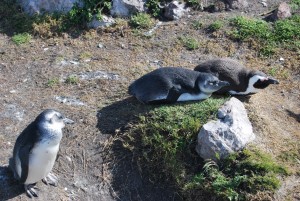In just two months a very special event will take place at various points in the Overstrand where I live and work, when Dr Sylvia Earle, world-renowned marine conservationist and National Geographic Explorer-in-Residence, visits and launches the Cape Whale Coast Hope Spot.
 < African penguins at the Stony Point colony in Betty's Bay, Cape Whale Coast Hope Spot[/caption]
An ambitious programme is being organised by the Cape Whale Coast Hope Spot (CWCHS) Organising Committee (for which I am a volunteer) to mark this historic occasion, which will include a dive and underwater plaque unveiling by Dr Earle at the Old Harbour, Hermanus. All activities in the ambitious programme will be filmed underwater, on land and from the air and streamed live which means that the public will be able to hear Dr Earle’s underwater speech during the plaque unveiling.
What is a Hope Spot?
< African penguins at the Stony Point colony in Betty's Bay, Cape Whale Coast Hope Spot[/caption]
An ambitious programme is being organised by the Cape Whale Coast Hope Spot (CWCHS) Organising Committee (for which I am a volunteer) to mark this historic occasion, which will include a dive and underwater plaque unveiling by Dr Earle at the Old Harbour, Hermanus. All activities in the ambitious programme will be filmed underwater, on land and from the air and streamed live which means that the public will be able to hear Dr Earle’s underwater speech during the plaque unveiling.
What is a Hope Spot?
Dr Earle, through the ocean community hub Mission Blue, created the idea of Hope Spots in 2009 to ignite public support for a global network of special marine management areas critical to the health of the oceans and the planet. As such Hope Spots promote an inclusive approach, whereby science, tourism, education, sustainable development and use of marine resources are possible.
These special areas act as a network of marine spaces designed to maintain biodiversity, provide a carbon sink, generate life-giving oxygen, preserve critical habitat and allow low-impact activities to thrive. Given the international profile of Dr Earle and Mission Blue, several key benefits of Hope Spots include global recognition and support for selected marine areas, and extensive promotion in the global tourism market. To date 50 Hope Spots have been declared on a worldwide basis.